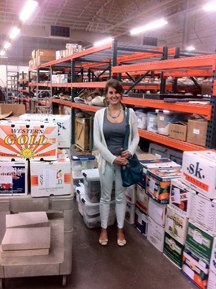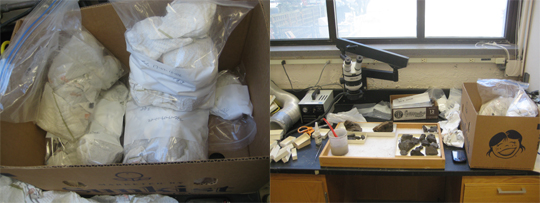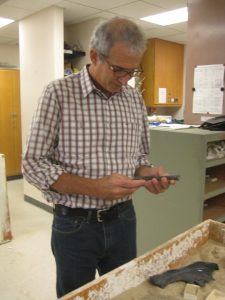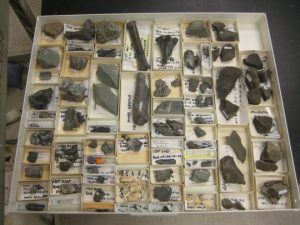
The UCMP houses one of the largest fossil collections associated with a university in the world, so it is no wonder that some of the fossils need to be stored off-campus at the UC Regatta facility, located nearby in Richmond. This large warehouse is home to multiple campus-wide museum collections, including a variety of enormous whale skulls, huge ichthyosaur skeletons, and cyclopean bones of mammoths and dinosaurs from the Museum of Paleontology.
The Regatta facility is also the current location of the fossils that have been recovered from the 4th bore Caldecott Tunnel project, and so I recently paid a visit. From the somewhat daunting pile of boxes, I selected several big, heavy ones labeled “vertebrates” and “invertebrates,” as well as some lighter, flat containers labeled “plants,” to take back to the UCMP in Berkeley. And the next day, I went to work.

Removing the lid of the first box revealed a pile of small bundles enveloped in toilet paper and neatly packed away in labeled plastic bags. After unwrapping a few of these small packages, I began to get an idea of the variety of fossils and rock samples that come from the Caldecott Tunnel. Most of the fossils I’ve seen so far are small, ranging in size from a tiny tooth several millimeters long, to some about as large as a fist. Many are broken or incomplete. But though they may not be visually impressive, they are rich in history. Not only will these fossils elucidate what the environment and climate of the East Bay was like in the middle Miocene Epoch, 9-16 million years ago, but they also provide clues about what happened to these organisms after they died. It is interesting, for example, that most of the invertebrate fossils are natural molds or ‘impressions’ in pieces of rock, while the vertebrates are preserved mainly as pieces of bones and teeth. Did they live in different habitats? Did they die in different places? How were these fossils preserved? These questions remain to be answered, and we’ll have to wait until further evidence comes in as I unpack and examine more material!
The plant fossils, however, are another story. Their preservation is quite good, and there are many leaves that can be seen very clearly, complete with anatomical details, on small slabs of rock. They are also especially interesting because they are particularly good indicators of the ancient climate of the San Francisco Bay Area, and provide a comparison of current and past geographic ranges of particular species. Watch for more on the Caldecott Tunnel fossils in future blog posts!

